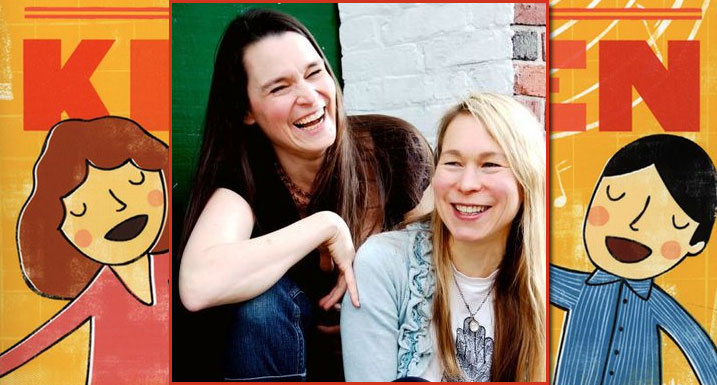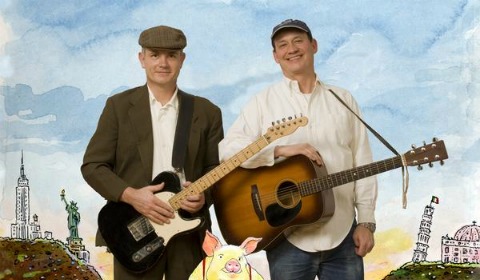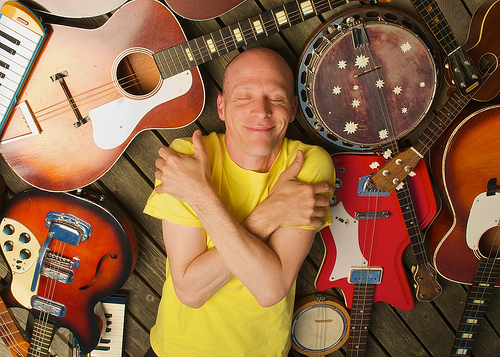
For as long as the human race has been able to hear music, we’ve wanted more. And once upon a time, we quenched that thirst by picking up an instrument — or gathering around someone else who had one — and making music happen.
Over time, we learned to develop technology that helped us satisfy our craving — and as more of us learned to use radios, record players, tape decks, CDs, mp3 players, and smartphones, and grew accustomed to a world in which music was never more than an arm’s reach (or the click of a button) away, the further we drifted from that innate urge to create. For a lot of us, music has become something we’re meant to passively consume.
I don’t think it’s supposed to be this way, and neither do a growing number of artists dedicated to reconnecting families with the joy of making music for its own sake, including Nerissa and Katryna Nields. The veteran folk duo recently released All Together Singing in the Kitchen: Creative Ways to Make and Listen to Music as a Family, a book/CD package with something for homestyle musicians of all ages, and they were kind enough to take a few minutes out of their busy promotional schedule to talk to us.
I talk to a lot of artists who express the ideas you’ve written about here. This book seems to be part of a movement.
Nerissa: Yeah. Well, that’s a nice bit of serendipity for us. One of the things we say in the book, and it’s absolutely true, is that it wasn’t until I was a teenager that I heard the recorded versions of a lot of the folk songs I’d grown up with. My dad did have a turntable, and he did play a lot of music, but he was playing what he wanted to hear — ’70s country LPs he’d bought, and occasionally classical music. Mostly, the songs we knew, we knew because he played them on the guitar. That’s how we learned them. That’s how you make a song your own, by passing it down through the oral tradition, rather than making a recording out of it.
I have a lot of respect for recording, too — obviously, we’re recording artists. But in terms of raising kids, I think it’s so wonderful to make a song your own. And that’s kind of what we do in all realms — we’ll take a beloved folk song and change the words, and encourage the kids to make their own versions.
Katryna: Observing art can be a transformative experience, but making art is almost always a transformative experience. And I think people are starting to realize that again.
I mean, a ukulele…you can pick one up and really know how to play a song in probably three months. That’s an exciting and liberating gift that it seems like people are beginning to rediscover.
I think my favorite story from the book is the one about the woman who inherited a mountain dulcimer and didn’t even think about learning how to play it until a random stranger suggested it — and then watched as music became a huge part of her child’s life.
Nerissa: Isn’t that amazing? I think it’s so inspiring.
It’s inspiring, but it also speaks to this weird disconnect we’ve developed in our relationship with music, where we can have an instrument literally in our hands and not think about playing it. Do you have any thoughts as to how we got to this point?
Katryna: Well, there was a time when the only way you could hear music is if you made it yourself. Even when we were kids, we had a turntable, but even then, it was a little bit of a cumbersome thing to put it on the turntable, get up and change it after 22 minutes or whatever it was, and in our cars, we had AM radio, and that was it. Now, it’s easy to carry a million songs around. You can see someone not wanting to learn how to play an instrument because all you need is an iPod.
Maybe, though, the pendulum is swinging in the other direction. I know that when I go to singalongs now, people often like to have iPads in the room so they can have the lyrics and chords handy.
The marriage of that technology with the simplicity of the guitar is such a cool thing to see.
Nerissa: I do think that our relationship with technology tends to move in a wave pattern. It takes a few leaps forward and we all go whoa, and then we catch up and make it our own, and then it leaps forward again. I think we’re in a catching-up phase right now. I think it would be interesting to chart the ebb and flow of folk music’s popularity against the technological tide — I wonder if one has anything to do with the other.
I often think about an old quote from Pete Seeger where he talked about being ambivalent about making albums, because he was worried that he was sort of tacitly encouraging people to be passive. We take recorded music for granted now, but at the time, it was a real decision for an artist to make, and I think it’s still thought-provoking.
Nerissa: For me, the two things definitely went hand in hand, because I remember being really daunted, as a teenager learning how to play guitar, by the things the Beatles were doing. I think it all depends on the attitude you take, and hopefully, what we’re giving people with this book is a “yes you can” attitude.
I wanted to talk about that message. Reading it reminded me of a time in the ’90s when I was talking to a producer about the way newly affordable recording technology had led to an explosion in self-released albums, and his response was that everyone thinks they have a right to make music, but they’re wrong.
Katryna: Well, that’s just commerce getting in the way.
Nerissa: I wouldn’t even say it’s commerce — I’d say it’s ego. I have a writer friend with whom I had a similar conversation in the early aughts, when self-publishing was starting to take off, and they had the same basic response. But good work rises and falls on its own merits.
Katryna: And also, the idea that every reader and every listener…I mean, is Lou Reed a good singer? I don’t know. But there are people who are moved beyond words by what he does, and how tragic would it have been if he’d decided he couldn’t sing and just not done it? It’s silly to think there’s a good and a bad when it comes to art. Some of the most moving recordings I’ve ever heard have been by complete amateurs.
I think when you invite this kind of stuff — writing, drawing, singing, crafting — into your life, what you’re doing is instilling a love of creativity in your kids. And no matter what their job ends up being, they will have that as part of their vocabulary. This way of not seeing the world as a boxed-in, linear thing, but something full of possibilities.
Nerissa: Right. The benefits of having music in your life are well-documented, but they bear repeating. It really pays dividends in terms of how it shapes the brain, and the heart, and the soul, in ways that are incalculable.
Katryna: I think one of our main theses with this book is the idea that by using music, you’re forging connections with your children that will hopefully remain throughout your family’s life. Some people do it by watching baseball with their kids. For us, it’s been music — that’s been the glue. It’s created pathways for us to communicate, and to remember that we’re from the same world. That we can be helpful to each other.

